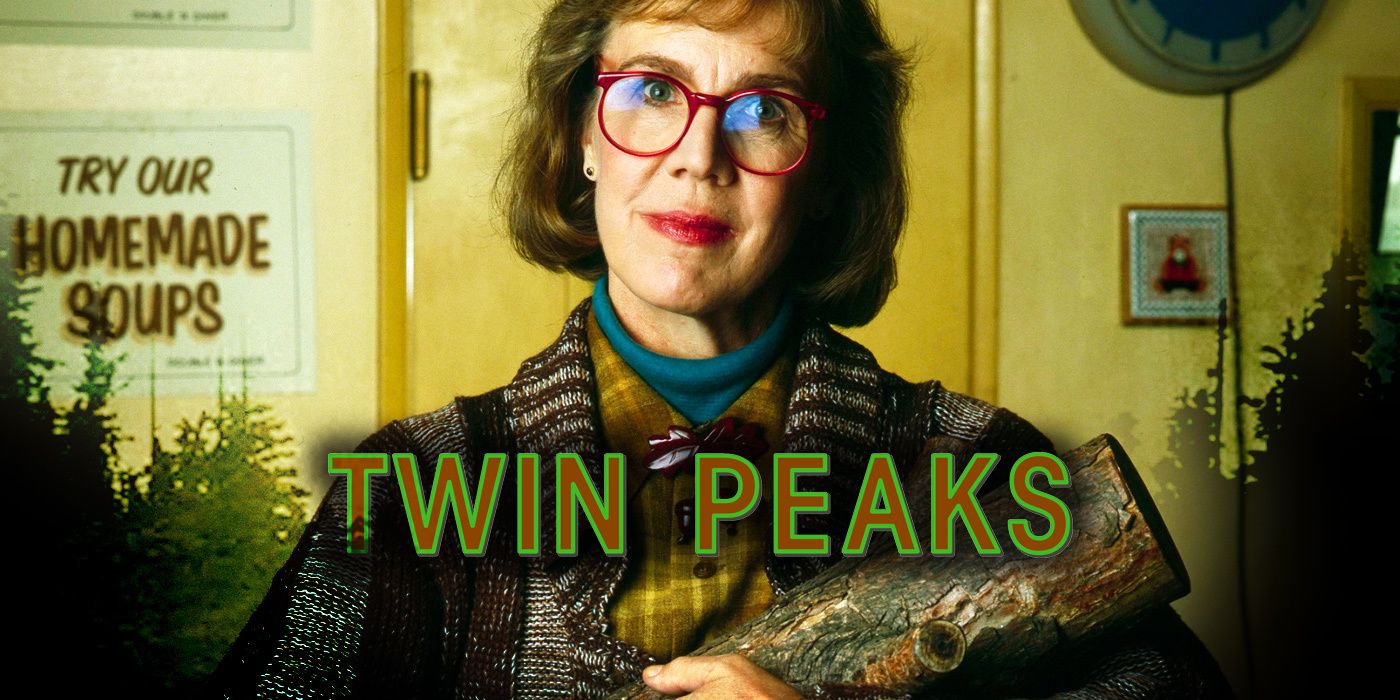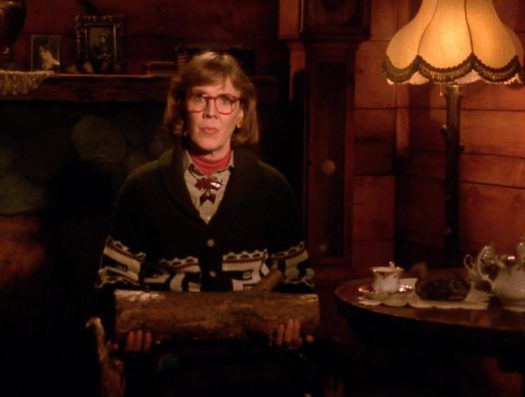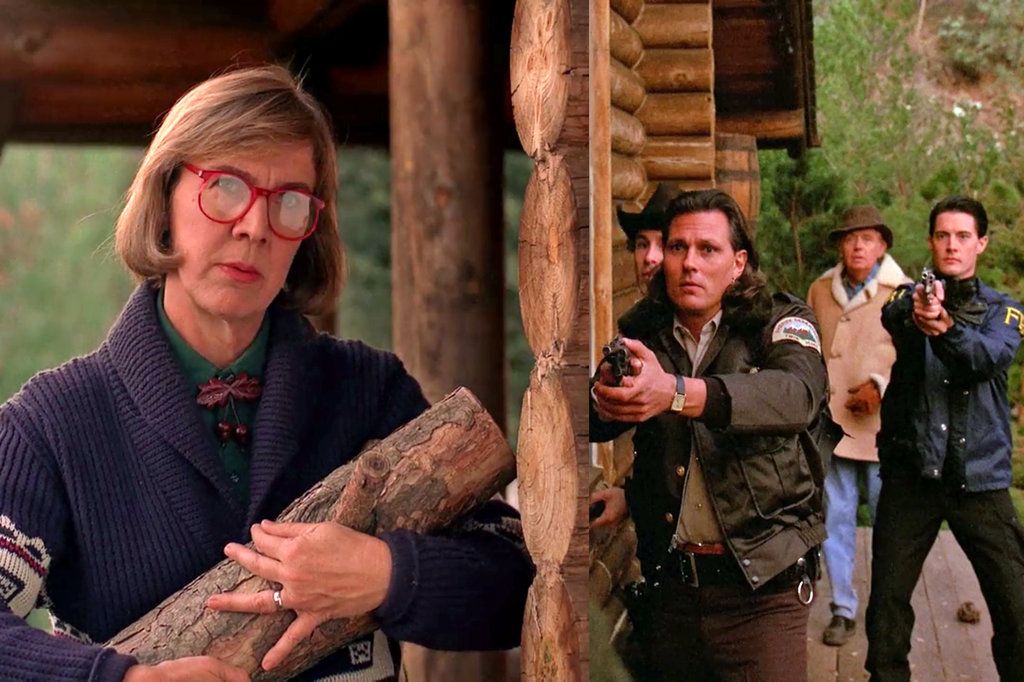Twin Peaks’ Margaret Lanterman (Catherine E. Coulson) – the Log Lady – has always been a fan favorite. For good reason, too. She delivers some of the best one-liners in the show, and holds the keys to many of the town's mysteries. It isn’t only Laura Palmer (Sheryl Lee) who is “full of secrets”, after all. Something particularly special for Log Lady fanatics, which you may not know about if you’re streaming Twin Peaks, is the Log Lady intros that were recorded for every episode of the original two seasons.
For those unfamiliar, Margaret is called the Log Lady because she carries a supposedly clairvoyant log around with her. She seemingly uses it to divine with a world unseen to help our protagonists, Agent Dale Cooper (Kyle MacLachlan) and Sheriff Harry S. Truman (Michael Ontkean), on their quest to uncover who killed Laura Palmer. “My log will have something to say about this,” Margaret says as she approaches the pair in the Double R Diner. During the Log Lady intros (of which there are a total of thirty installments), the viewers also get the opportunity to find out what the “log has to say about this.” On the DVD release of the series, every episode starts out with a monologue by the Log Lady, lasting from thirty seconds up to around two minutes. Margaret breaks the fourth wall by speaking directly to us, the viewers, in the living room of her log cabin.
“There are many stories in Twin Peaks,” Margaret informs the camera during her introduction for “Episode 0,” the pilot episode. While this statement is safe to assume from the get-go, some of Margaret’s messages aren’t always so apparent, particularly for a first-time viewer. But, for those rewatching the series, it becomes immediately clear that Margaret was dropping hints about the town’s “many stories” and giving the audience a look into some of the series’ wider lore along the way. During her second monologue, from “Episode 1,” she says, “Behind all things are reasons. Reasons can even explain the absurd. Do we have the time to learn the reasons behind the human behavior?” We might not, but it’s clear that Margaret has the time, at least for the reasons behind Twin Peaks absurdity – which is perhaps what it is known for best. Maybe if we, the audience, take a little time to sit with her, we will learn the reasons, too.
Some of the intros provide a wider look into the world of Twin Peaks, as opposed to strictly foreshadowing the plot, inviting us into the town as outsiders, much like Cooper or Jocelyn Packard (Joan Chen). One intro focusses entirely on the Double R Diner, coffee, pie, and how Margaret feels towards Norma Jennings (Peggy Lipton): “I hope Norma likes me. I know I like her and respect her.” It’s a sweet, confessional look at a side of Margaret that you wouldn’t necessarily get to see in the main body of work, paired with a piece of backstory that the show’s phenomenal writing makes you yearn for. This is part of what makes the Log Lady intros so charming – they help you to get to know a world you’re dying to know about.
Part of the charm of the town that Mark Frost and David Lynch co-created is the fantastic world-building that makes the viewer feel just as much a part of the adventure as any of the characters, from inviting us into the iconic Roadhouse down to making us long for Norma’s cherry and huckleberry pies. Margaret’s preambles to every episode are crucial to establishing and nurturing these feelings. The breaking of the fourth-wall creates a sense of conversational intimacy with the Log Lady: you’re in her living room, she’s speaking directly to you, she’s trusting you with Twin Peaks’ secrets. While the secrets Margaret shares are sometimes about internal town politics, brunch, and pitch gum, sometimes they’re about something much more.
The Log Lady intros can be immensely important to piecing together the puzzles that Twin Peaks leaves unsolved. Much of the series’ themes and meanings are up for debate, and intentionally so. This ambiguity is part of the beauty of any Lynch/Frost production. But, it’s only natural to want to dig a way through the canon to try and find answers, particularly given the many unanswered questions left both by design, and also by the series’ early cancelation. Thankfully, Margaret is excellent at filling in the blanks to help the audience find answers that satisfy them.
The Easter eggs given in these intros run deep into the series’ storytelling. During the preamble for “Episode 15,” Margaret says “Seven is difficult to balance, but not impossible – we are able to divide.” Long before the audience was made aware of Bad Cooper, Cooper’s BOB-infused doppelganger from the Black Lodge, the seeds were being sown into the audience’s mind of “dividing” into multiple beings. Margaret's divinitive log seems to be able to expect the unexpected, and Margaret is kind enough to share that skill with us.
Furthermore, while Margaret’s reference to the number seven in this monologue may be purely to illustrate division in a mathematical sense, seven (and its repetition) is referred to as an “angel number”. Themes of being a guardian angel, alongside otherwise angelic imagery, were used increasingly as the franchise progressed, from actual angels at the end of Twin Peaks: Fire Walk with Me (1992) to Cooper acting as a guardian for Laura during the final few episodes of Twin Peaks: The Return (2017).
Numbers are persistently important throughout The Return, too, with every episode containing numerical hints on pylons and in coded messages. With all of this in mind, it’s possible that Margaret’s monologues were giving a sneak peek of what was yet to come in the saga of Twin Peaks even 25 years prior to the series’ follow-up. Or, it could of course have been a regular piece of Lynch/Frost eccentricity: in the 2007 documentary A Slice of Lynch, Lynch mentions that his favorite number is seven, and given his ongoing number-related YouTube videos, it wouldn’t be entirely unexpected for it to be coincidental.
The spurious numerical connections aren’t the only precursors to Fire Walk with Me and The Return that the Log Lady alluded to. Throughout the clips, she refers to magical trees that are from dreams of “suffering and pain”, much like the post-25 year gap form The Arm (Michael J. Anderson) takes on in the Red Room. In another, she mirrors lines spoken by various Lodge spirits in scenes from the movie. During the monologue for "Episode 9," she appears to almost be in direct dialogue with both the Man from Another Place’s (Michael J. Anderson) lines regarding creamed corn/”Garmonbozia,” and also with lines cut from the Fire Walk with Me script for Mrs. Tremond (Frances Bay). Margaret’s understanding of Twin Peaks, and the knowledge she has to share with the audience in her monologues, is beyond that of the episodes they are attached to.
It’s easy to wonder if some of Twin Peaks’ secrets would have remained discreet without Margaret there to guide the audience through them, leaving a breadcrumb trail of clues and ideas to latch onto. Whether these concepts are "fanon" and speculation or widely accepted lore, it’s information the fans wouldn’t have ever gotten a look at without these quirky clips of footage. With these monologues even potentially foreshadowing events in prequels and sequels of the show’s original run, perhaps the Log Lady intros still hold secrets yet to be understood. The mysterious owls may be the eyes for BOB, but the Log Lady is the eyes for the viewers, a fly on the wall of the strange little town in Washington State, five miles south of the Canadian border. Without the Log Lady, the audience's understanding of Twin Peaks would be forever changed.



